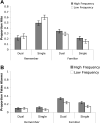The low-frequency encoding disadvantage: Word frequency affects processing demands
- PMID: 16822148
- PMCID: PMC2387211
- DOI: 10.1037/0278-7393.32.4.805
The low-frequency encoding disadvantage: Word frequency affects processing demands
Abstract
Low-frequency words produce more hits and fewer false alarms than high-frequency words in a recognition task. The low-frequency hit rate advantage has sometimes been attributed to processes that operate during the recognition test (e.g., L. M. Reder et al., 2000). When tasks other than recognition, such as recall, cued recall, or associative recognition, are used, the effects seem to contradict a low-frequency advantage in memory. Four experiments are presented to support the claim that in addition to the advantage of low-frequency words at retrieval, there is a low-frequency disadvantage during encoding. That is, low-frequency words require more processing resources to be encoded episodically than high-frequency words. Under encoding conditions in which processing resources are limited, low-frequency words show a larger decrement in recognition than high-frequency words. Also, studying items (pictures and words of varying frequencies) along with low-frequency words reduces performance for those stimuli.
Copyright 2006 APA, all rights reserved.
Figures







Similar articles
-
A reexamination of stimulus-frequency effects in recognition: two mirrors for low- and high-frequency pseudowords.J Exp Psychol Learn Mem Cogn. 2002 Jan;28(1):138-52. doi: 10.1037//0278-7393.28.1.138. J Exp Psychol Learn Mem Cogn. 2002. PMID: 11827076 Free PMC article.
-
Picture superiority in conceptual memory: dissociative effects of encoding and retrieval tasks.Mem Cognit. 2000 Oct;28(7):1165-72. doi: 10.3758/bf03211817. Mem Cognit. 2000. PMID: 11126939 Clinical Trial.
-
A bias in favor of the positive response to high-frequency words in recognition memory.Mem Cognit. 1991 Nov;19(6):607-16. doi: 10.3758/bf03197156. Mem Cognit. 1991. PMID: 1758305
-
Investigating the encoding-retrieval match in recognition memory: effects of experimental design, specificity, and retention interval.Mem Cognit. 2010 Dec;38(8):1101-9. doi: 10.3758/MC.38.8.1101. Mem Cognit. 2010. PMID: 21156873
-
The word-frequency paradox for recall/recognition occurs for pictures.Psychol Res. 2004 Aug;68(4):271-6. doi: 10.1007/s00426-003-0138-5. Epub 2003 Jun 25. Psychol Res. 2004. PMID: 12827353
Cited by
-
Examining the role of context variability in memory for items and associations.Mem Cognit. 2018 Aug;46(6):940-954. doi: 10.3758/s13421-018-0813-9. Mem Cognit. 2018. PMID: 29713960
-
Cortical Networks Involved in Memory for Temporal Order.J Cogn Neurosci. 2017 Jul;29(7):1253-1266. doi: 10.1162/jocn_a_01123. Epub 2017 Mar 15. J Cogn Neurosci. 2017. PMID: 28294716 Free PMC article.
-
The zoom lens of attention: Simulating shuffled versus normal text reading using the SWIFT model.Vis cogn. 2012 Apr;20(4-5):391-421. doi: 10.1080/13506285.2012.670143. Epub 2012 May 23. Vis cogn. 2012. PMID: 22754295 Free PMC article.
-
The bilingual L2 advantage in recognition memory.Psychon Bull Rev. 2013 Dec;20(6):1296-303. doi: 10.3758/s13423-013-0427-y. Psychon Bull Rev. 2013. PMID: 23606134
-
Bilingual recognition memory: stronger performance but weaker levels-of-processing effects in the less fluent language.Mem Cognit. 2012 Apr;40(3):496-503. doi: 10.3758/s13421-011-0163-3. Mem Cognit. 2012. PMID: 22086650
References
-
- Clark SE. Word frequency effects in associative and item recognition. Memory & Cognition. 1992;20:231–243. - PubMed
-
- Clark SE, Shiffrin RM. Cuing effects and associative information in recognition memory. Memory & Cognition. 1992;20:580–598. - PubMed
-
- Cohen JD, MacWhinney B, Flatt M, Provost J. PsyScope: A new graphic interactive environment for designing psychology experiments. Behavioral Research Methods, Instruments, and Computers. 1993;25:257–271.
-
- Coltheart M. The MRC psycholinguistic database. Quarterly Journal of Experimental Psychology. 1981;33A:497–505.
-
- Deese J. Frequency of usage and number of words in free recall: The role of association. Psychological Reports. 1960;7:337–344.

